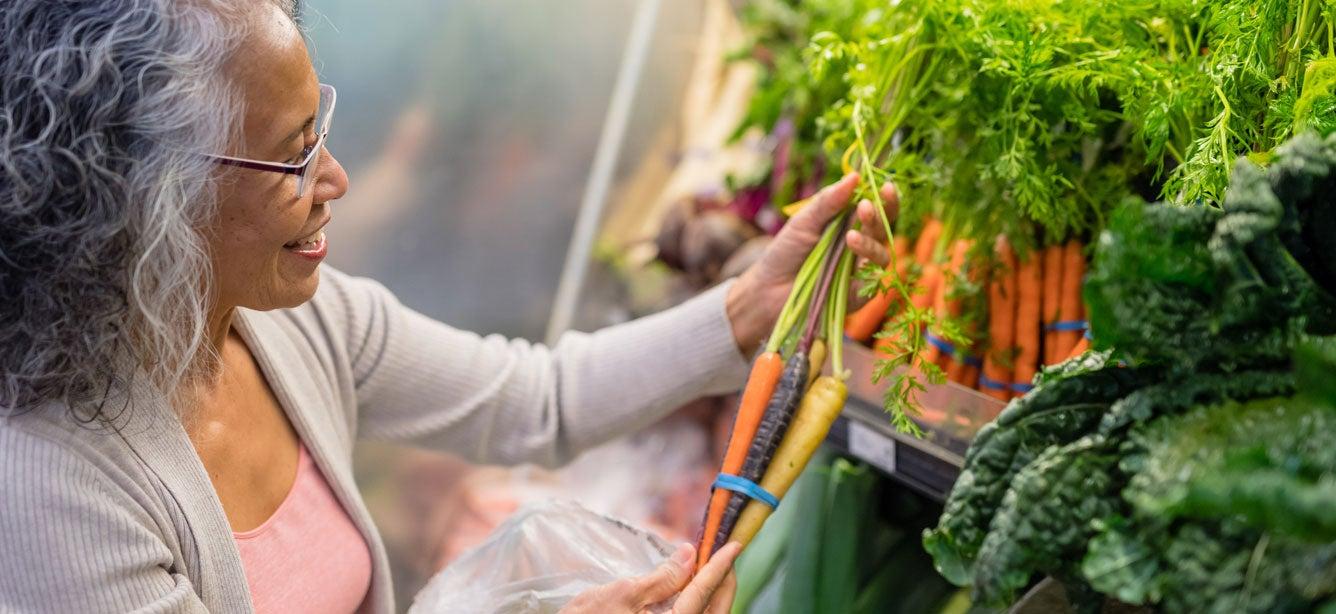
Related Topics
In 2023, 7.4 million older adults were food insecure.1 And when we're food insecure, we often lack sufficient calories and nutrients and have a lower-quality diet than people who have enough to eat—all of which can have a negative impact on our health.
As the largest hunger safety-net program in the U.S., the Supplemental Nutrition Assistance Program (SNAP) helps nearly 8 million2 of us put nutritious and satisfying food on the table. Not only does SNAP reduce our prospects of hunger; it also supports our overall health and well-being in many important ways.
Ms. W., age 63, is a real-life example of SNAP's impact. As a result of severe health issues, she is no longer able to work or drive. She's using the little savings she has for healthcare expenses, and there's not much left to buy food each month. Thankfully, SNAP assistance has made it easier for Ms. W. to stock her fridge.
"Before, I was having just one meal a day," she told NCOA. "Now I'm able to get the food I need."
What are some of the health benefits of SNAP?
1. SNAP provides access to fresh produce and other healthy foods we might otherwise not be able to afford.
Since 1980, the Dietary Guidelines for Americans have provided science-based advice on what we should eat and drink to meet our daily nutrient needs. According to the latest guidelines, older adults should consume more fruit, vegetables, whole grains, and dairy in order to support healthy aging.
The average SNAP benefit per person in 2024 was $187.20 per month—extra funds we can use to add more nutritious food to our diet.2
Ms. Vang, a 69-year-old from Minneapolis, credits food benefits like SNAP for helping her to eat healthier while living with high blood pressure and diabetes. “Now I can buy more healthy foods such as fresh vegetables and fruits which I normally couldn’t afford,” Vang told her Benefits Enrollment Center advocate, who helped her enroll into the program.
What can SNAP benefits be used for? A SNAP EBT card can be presented at grocery and convenience stores to buy fruits and vegetables, meats, poultry, fish, breads, cereals, dairy products, and non-alcoholic beverages. SNAP benefits can even be used at participating local farmers markets, which lets you buy some of the freshest, most delicious produce available.
2. SNAP can help prevent chronic disease.
Not getting enough of the right nutrients puts us at risk for developing (or making worse) chronic health conditions such as obesity, diabetes, asthma, high blood pressure, and congestive heart failure. In addition, the financial stress related to ongoing food insecurity is thought to contribute to a more rapid onset or progression of chronic disease.4
Food insecurity has also been linked to poorer overall health, depression, muscle weakness, and decreased bone mass, which may lead to conditions like osteoporosis.5 By adding more nutrient-dense foods to our diets using SNAP benefits, we can reduce our risk of debilitating health problems that compromise our quality of life.5
3. SNAP can help reduce the risk of falls.
Each year, more than 3 million older adults sustain injuries by falling. Many falls are caused by frailty and vitamin D deficiency—both linked to food insecurity and poor nutrient intake. Addressing food insecurity through programs like SNAP may help reduce fall rates among our age group.
4. SNAP can help us continue to live independently.
In addition to reducing falls that may land us in the hospital, a balanced diet can also help us maintain the strength and mobility we need to take care of ourselves. This empowers us to age in place and keep leading an active and independent life. Having access to enough food for a nutritious diet helps us better recovery from surgery and injuries as well. It even plays a role in how fast wounds heal.
5. SNAP has been linked with better medication adherence.
If we're food insecure, we may be tempted to cut costs in other areas in order to afford groceries. This might mean skipping doses of prescribed medications, delaying refills, or even cutting doses in half. SNAP provides critical assistance that makes food more affordable, leaving extra money for us to put toward medications, medical care, and other health-promoting activities.3 One study found that SNAP participation may help older adults with diabetes stick to their treatment regimens.6
6. SNAP may help improve health care outcomes.
According to one North Carolina-based study, SNAP enrollment is associated with fewer emergency room visits, hospital stays, and long-term care admissions.7
7. SNAP contributes to lower health care costs.
High health care costs affect all of us—particularly those with low incomes. Poor diets contribute to nearly 20% of U.S. health care costs stemming from chronic conditions like diabetes and heart disease. This equates to approximately $50 billion each year.8
The North Carolina study mentioned above found that SNAP participation can help lower Medicaid costs. The improved healthcare outcomes resulting from SNAP assistance translated into an estimated $2,360 reduction in Medicaid spending per person annually. Another study linked SNAP participation with shorter, less expensive hospital stays.9
Do you need SNAP assistance? Find out if you’re eligible.
Nationally, about 7.8 million people age 60+ are enrolled in SNAP.2 Still, too many older adults are still missing out on vital benefits that can help improve their life. Could you be one of them?
Use NCOA’s BenefitsCheckUp to check your eligibility for programs that can help you pay for food, housing, utilities, prescription drugs, health care, and more.
Sources
1. A. Dewey et al. Map the Meal Gap” A Report of Local Food Insecurity and Food Costs in the United States in 2023. Feeding America. May 2025. Found on the internet at https://www.feedingamerica.org/sites/default/files/2025-05/Map%20the%20Meal%20Gap%202025%20Report.pdf
2. USDA. Supplemental Nutrition Assistance Program (SNAP) - Key Statistics and Research. July 24, 2025. Found on the internet at https://www.ers.usda.gov/topics/food-nutrition-assistance/supplemental-nutrition-assistance-program-snap/key-statistics-and-research
3. Steven Carlson and Brynne Keith-Jennings. SNAP is Linked with Improved Nutritional Outcomes and Lower Health Care Costs. Center for Budget and Policy Priorities. Jan. 17, 2018. Found on the internet at https://www.cbpp.org/research/food-assistance/snap-is-linked-with-improved-nutritional-outcomes-and-lower-health-care
4. Barbara Laraia. Food Insecurity and Chronic Disease. Advances in Nutrition. March 2013. Found on the internet at https://academic.oup.com/advances/article/4/2/203/4591628
5. Dana DeSilva and Dennis Anderson-Villaluz. Nutrition as We Age: Healthy Eating with the Dietary Guidelines. U.S. Office of Disease Prevention and Health Promotion. July 20, 2021. Found on the internet at https://health.gov/news/202107/nutrition-we-age-healthy-eating-dietary-guidelines
6. Jennifer A. Pooler and Mithuna Srinivasan. Association Between Supplemental Nutrition Assistance Program Participation and Cost-Related Medication Nonadherence Among Older Adults With Diabetes. JAMA Internal Medicine. January 2019. Found on the internet at https://www.ncbi.nlm.nih.gov/pmc/articles/PMC6583428/
7. Benefits Data Trust. Building Healthier Lives through Increased SNAP Participation. December 2021. Found on the internet at https://bdtrust.org/berkowitz-fact-sheet-121721.pdf
8. Harvard T.H. Chan School of Public Health. Poor diets linked to $50 billion in U.S. health care costs. December 2019. Found on the internet at https://www.hsph.harvard.edu/news/hsph-in-the-news/poor-diets-health-care-costs/
9. Laura J. Samuel, et al. Does the Supplemental Nutrition Assistance Program Affect Hospital Utilization Among Older Adults? The Case of Maryland. Population Health Management. April 2018. Found on the internet at https://www.ncbi.nlm.nih.gov/pmc/articles/PMC5906726



